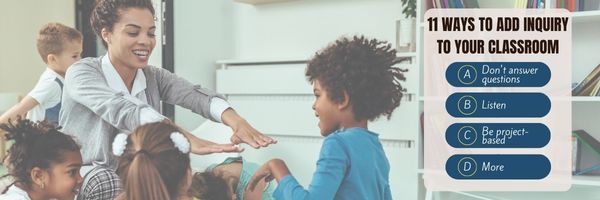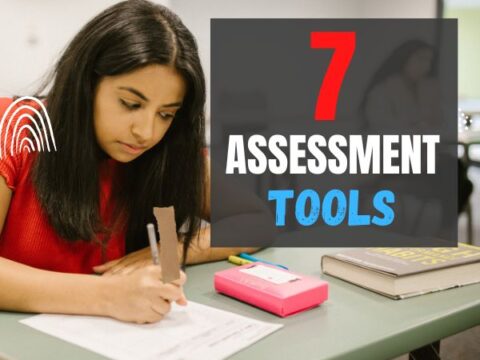You became a teacher not to pontificate to trusting minds, but to teach children how to succeed as adults. That idealism infused every class in your credential program and only took a slight bump during your student teacher days. You graduated sure you’d never teach to the test or lecture for 90% of a class.
Then you got a job and reality struck. You had lesson plans to get through, standards to assess, meetings to attend, parents to council, and state-wide tests that students must do well on. A glance in the mirror said you were becoming that teacher you hated in school. You considered leaving the profession. Until a colleague mentioned the inquiry-based classroom, where teaching’s goal was not the solution to a problem but the path followed. It’s what you’d hoped to do long ago when you started–but how do you turn a traditional entrenched classroom into one that’s inquiry-based?
Here are 11 ideas. One or more will resonate with your teaching style:
Don’t answer student questions–show them how to do it themselves.
Show students how to find answers to their questions. When students understand the methodology, they can repeat the process. How students reach conclusions is as important as the conclusions. Think back to your favorite school lessons. Were they where you learned the capital of every state or where you came to understand the scientific method? (Maybe that comparison doesn’t work, but you get my point–your favorite lessons allowed you to think).
Questions often don’t have yes-no answers
Or don’t even a concrete one. They are more ‘how’ and ‘why’, which requires investigation into multiple strands to answer. Assessment becomes the student ability to use problem-solving and thinking skills, not to repeat someone else’s conclusions.
Listen when students speak
It’s tempting to think you know what students are going to ask/say. Resist the impulse. Listen. Try to understand the inquiry behind the spoken words.
Encourage questions
But class time is ticking away. If you take time to answer all the questions, you won’t cover the material scheduled. Take the time. Make the issues clear. An odd thing will start to happen. As students more thoroughly understand a concept, they will transfer that knowledge to other lessons and those will go faster than expected. By the end of the year, you’ll have covered more material in more depth. Cool, hunh?
Learning isn’t linear
It grows outward from the central question. Your lesson plan may change dramatically based on student inquiry. If you teach three fifth grade classes, each will likely be different from the other. That’s OK. In fact, if they aren’t different, you may be doing something wrong.
Spend time on projects
There’s an old Chinese proverb, although Ben Franklin occasionally gets credit for these words:
“Tell me and I’ll forget.
Show me and I may remember.
Involve me and I’ll understand.”
Inquiry is about doing, not observing.
Publish and share
Inquiry-based classrooms share knowledge. This can be accomplished digitally. Students learn to embed articles and projects into the class digital bulletin board to share with everyone. They are encouraged to ask questions about shared materials, read and comment on them, and use them as resources. We all grow when one grows.
Reflection is part of every lesson
What did students learn? Where can they transfer it? You as teacher do that after every teaching experience. Your students do it also. It helps you understand if what they learned was what you planned. Or something else.
You are a fellow learner
Accept that the inquiry-based classroom will be noisier than the typical class–and that’s a good thing. Students learn they are valued in the classroom. Their conclusions bend discussion, mold learning. In this way, they understand the importance of their participation.
Summative assessments are less paper-and-pencil and more hands-on, creative, and student-centered
They are less about answering teacher questions than sharing learning. You might even have students create their own assessments in something like PuzzleMaker.
Flip the classroom
The night prior to a lesson, have students read the lecture materials so you can spend class time in hands-on discovery.
***
That’s it–eleven ideas. Any handful of these approaches will morph your classroom from passive to energetic, boring to brilliant. In the comments, share what happened the first time you tried to remove the pedagogic anchor and set your class lose. Copyright ©2023 AskaTechTeacher.com – All rights reserved.
Here’s the sign-up link if the image above doesn’t work:
Jacqui Murray has been teaching K-18 technology for 30 years. She is the editor/author of over a hundred tech ed resources including a K-12 technology curriculum, K-8 keyboard curriculum, K-8 Digital Citizenship curriculum. She is an adjunct professor in tech ed, Master Teacher, webmaster for four blogs, an Amazon Vine Voice, CSTA presentation reviewer, freelance journalist on tech ed topics, and author of the tech thrillers, To Hunt a Sub and Twenty-four Days. You can find her resources at Structured Learning.







































1 thought on “11 Ways to Add #Inquiry to Your Class”
Comments are closed.